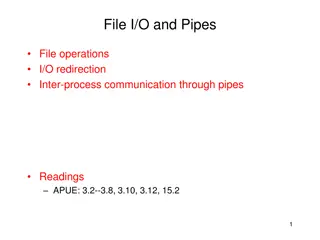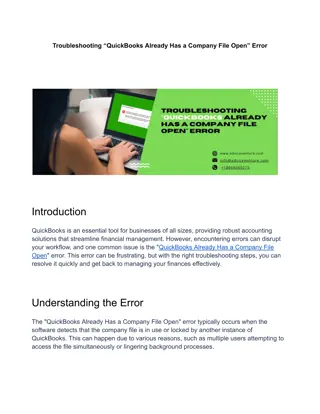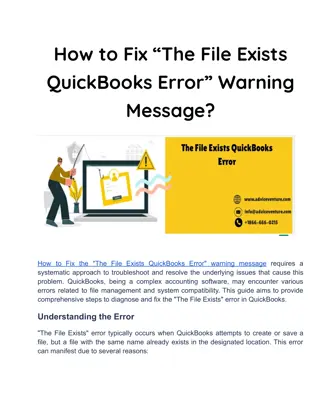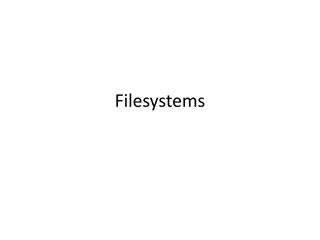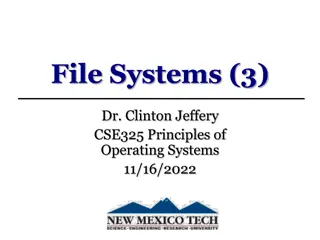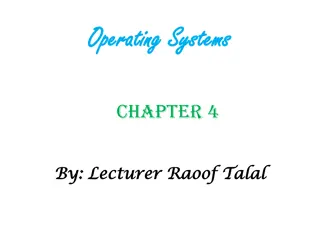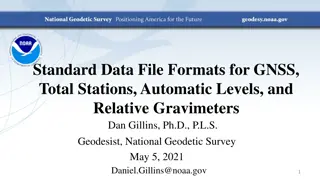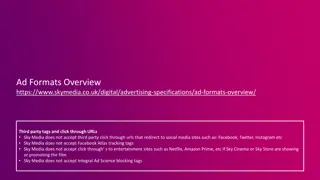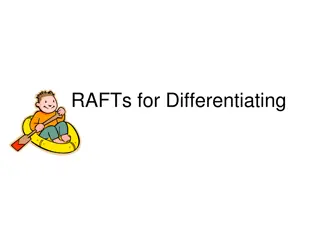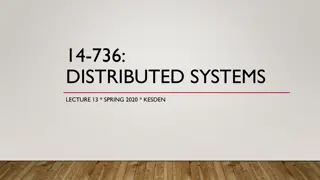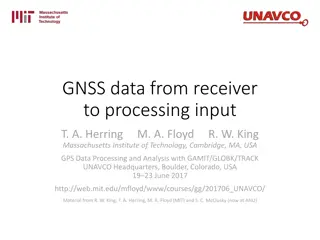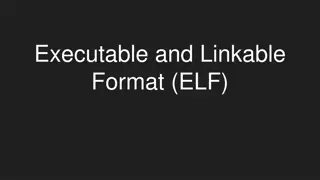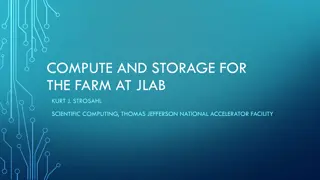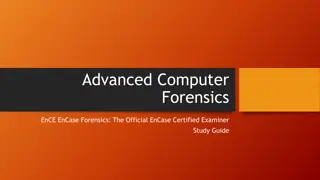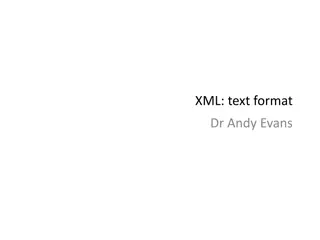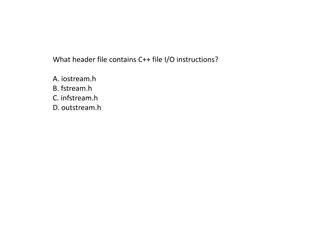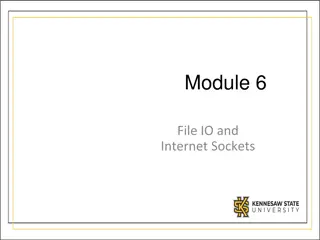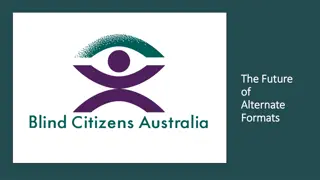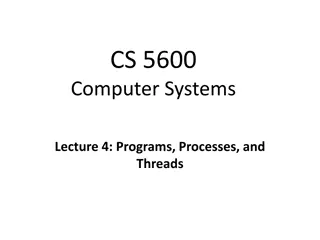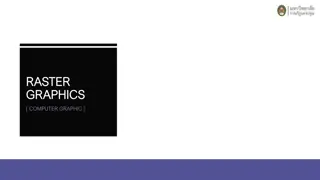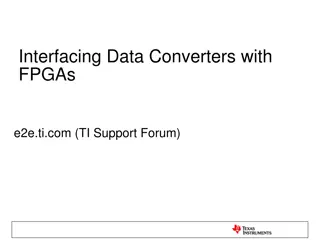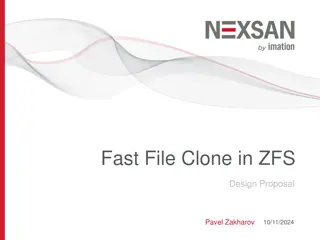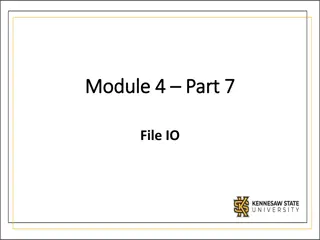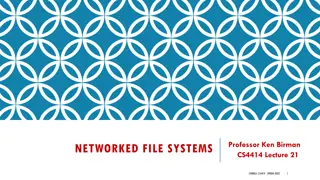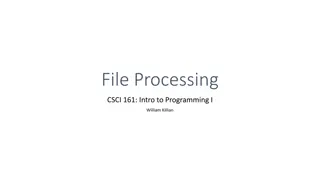Understanding File I/O and Inter-Process Communication Through Pipes
Delve into the intricacies of file operations, I/O redirection, and inter-process communication through pipes as discussed in the readings of "Advanced Programming in the Unix Environment" (APUE). Explore data structures for open files, file descriptor tables, implications of data structures, system
4 views • 18 slides
Faculty File Construction Workshop Year 2 Updates 2023
Explore the updates for the Faculty File Construction Workshop Year 2, including important resources, faculty plan requirements, and the purpose of decision file procedure. Learn about the required second-year file content and self-evaluation executive summary for faculty evaluation procedures at St
1 views • 18 slides
How to Fix Quickbooks Error 80070057?
How to Fix Quickbooks Error 80070057?\nQuickBooks Error 80070057 can disrupt financial management. It occurs due to file extension issues or data damage. Symptoms include inability to open files and error code display. Causes involve incorrect file extensions or firewall settings. Diagnostic tools l
1 views • 5 slides
Troubleshooting “QuickBooks Already Has a Company File Open” Error
Troubleshooting \u201cQuickBooks Already Has a Company File Open\u201d Error\nEncountering the \"QuickBooks Already Has a Company File Open\" error? This common issue disrupts your workflow but can be fixed. Start by checking for multiple instances of QuickBooks and restarting your computer. Ensure
1 views • 6 slides
How to Fix “The File Exists QuickBooks Error” Warning Message
How to Fix the \"The File Exists QuickBooks Error\" warning message requires a systematic approach to troubleshoot and resolve the underlying issues that cause this problem. QuickBooks, being a complex accounting software, may encounter various errors related to file management and system compatibil
0 views • 5 slides
Understanding Filesystems: A Comprehensive Overview
File systems provide a structured approach to storing and organizing data on secondary storage devices. They involve logical organization of files, directories for grouping related files, sharing data between users, and managing permissions. Files contain data with attributes like size, ownership, a
1 views • 29 slides
Understanding File Allocation Strategies in Operating Systems
Explore various file allocation schemes like extent-based systems, linked allocation, file allocation table (FAT), indexed allocation, and combined schemes used in operating systems. Learn about their pros and cons, including details on maximum file size calculations based on disk block sizes and po
0 views • 20 slides
Operating System: File Allocation Methods
File allocation methods in operating systems determine how files are stored in disk blocks. The main methods include Contiguous Allocation, Linked Allocation, and Indexed Allocation. Contiguous Allocation involves allocating blocks in a contiguous manner for efficient disk space utilization and fast
0 views • 14 slides
Implementation of File System in Operating Systems
Various structures, such as boot control blocks and directory implementations, play a crucial role in implementing a file system in operating systems. These structures help in managing disk and in-memory data efficiently, ensuring effective file storage and retrieval. Linear lists and hash tables ar
1 views • 22 slides
Standard Data File Formats for Geospatial Instruments
Understanding the importance of standard file formats for GNSS, total stations, automatic levels, and relative gravimeters to facilitate data exchange, processing, and preservation in the geospatial industry. Exploring the significance of RINEX and other XML-based formats, along with examples and th
2 views • 30 slides
Understanding the Implementation of XML Results File G for Exams in England and Wales
The XML Results File G is introduced as a new method to provide schools with additional exam data beyond overall results. Initially used by four boards, the file follows the A2C XML Schema for compatibility with SIMS7 and NextGen. While optional for now, the XML file naming convention and guidelines
1 views • 43 slides
Sky Media Advertising Specifications Overview
Sky Media specifies ad formats and restrictions, including limitations on third-party tags, click-through URLs, and certain tracking tags. The overview covers website and app formats, loading requirements, file size guidelines, and creative considerations for successful advertising campaigns.
0 views • 19 slides
Differentiated RAFT Strategies for Engaging Writing Across the Curriculum
RAFTs, an engaging high-level strategy, encourage students to assume roles, consider audiences, write in specific formats, and explore topics. This method motivates students by offering choice and aligning with their interests and learning profiles. Differentiating RAFTs by readiness involves assign
0 views • 15 slides
Understanding Distributed File Systems
A distributed file system manages files across multiple machines on a network, providing users with a seamless experience as if they were using a local file system. This system abstracts details such as file locations, replicas, and system failures from the user, ensuring efficient and reliable file
0 views • 35 slides
Understanding File Extraction Methods: Tech Skills 201 Overview
Learn to extract files from compressed or archive formats, navigate command line interfaces, and understand virtual machines in digital preservation workflows. Discover how to handle compressed files on Windows, Mac, and Linux, including popular formats like .zip, .tar, and .dmg. Detailed instructio
0 views • 27 slides
Safety Director 101: The Driver Qualification File
The Driver Qualification (DQ) File is a critical element in safety programs, ensuring compliance with Part 391 Qualification of Drivers in the Federal Motor Carrier Safety Regulations. DQ files must be kept up-to-date with quarterly reviews, spot checks, new hire reviews, and policy updates. Buildin
1 views • 25 slides
Technology Fundamentals for Digital Preservation
This course covers common computer systems, file formats, open-source software, and the OAIS standard for digital preservation. Participants will learn about operating systems, file systems, and file format preservation issues. The course also explores the differences between Windows and Unix operat
1 views • 80 slides
Example of COI Disclosure Formats in Academic Presentations
These images provide examples of Conflict of Interest (COI) disclosure formats for oral and poster presentations in academic settings. They outline how authors can disclose any potential COIs in relation to their work over the past three years, including details on employment, stock ownership, paten
1 views • 4 slides
Analysis of file:// Vulnerabilities in Android Browser Apps
The study delves into file:// vulnerabilities in Android browser apps, uncovering risks posed by the file:// URI scheme. It highlights how file:// requests can breach app data isolation, potentially compromising sensitive files. The research presents a unified attack model, FileCross automated testi
0 views • 22 slides
Understanding GNSS Data Processing with RINEX Formats
Explore the journey of GNSS data from receiver to processing input, focusing on the motivation behind the Receiver INdependent EXchange (RINEX) format and the evolution from RINEX 2 to RINEX 3. Learn about raw data formats, RINEX file conventions, and the significance of RINEX 2 data format in GPS o
1 views • 15 slides
Understanding Executable and Linkable Format (ELF)
Executable and Linkable Format (ELF) is a crucial file format for running programs, managing memory permissions, controlling program execution, and handling shared libraries. This article discusses the significance of executable formats, the common executable formats like ELF, PE, Mach-O, and ORC, a
0 views • 13 slides
Compute and Storage Overview at JLab Facility
Compute nodes at JLab facility run CentOS Linux for data processing and simulations with access to various software libraries. File systems provide spaces like /group for group software, /home for user directories, and Cache for write-through caching. Additionally, there are 450TB of cache space on
0 views • 11 slides
Understanding File Systems and Disk Basics in Computer Forensics
Explore the fundamentals of file systems and disk basics in computer forensics, covering topics such as disk preparation, partitioning, volume creation, file system formatting, FAT basics, and file allocation tables. Learn about disk structures, cluster allocation, and the functioning of FAT version
0 views • 24 slides
ENOVIA V6 File Name Cleanup for Data Migration
Problematic file names with unsupported characters can hinder data migration into ENOVIA V6, impacting object busname, titles, and filenames. This article proposes a solution involving filename changes, database updates, and file vault maintenance. The methodology includes SQL queries for analysis,
0 views • 5 slides
Understanding GPS Data Processing and RINEX Formats
Learn about the process of transferring GPS data from receivers to processing input, the importance of RINEX formats for universal data exchange, different raw data formats, motivation behind RINEX development, and details about RINEX versions. Explore RINEX 2 data format, its file naming convention
0 views • 13 slides
Evolution of Data Formats in Information Technology
Over time, as data space became more affordable, there has been a shift towards text-based data formats in information technology. This evolution has led to a transition from binary formats to text, making data more understandable for both humans and coders. The move to open data formats, based on i
0 views • 19 slides
Understanding C++ File I/O Operations
Learn about C++ file I/O operations, including input/output instructions, file handling with ifstream and ofstream, opening multiple files, checking end of file, and a review of the file I/O process. Discover how to write to an ASCII file and read data from it in C++ programming. Practice with examp
0 views • 47 slides
Understanding File Input/Output in Java
Learn about file input/output operations in Java. Explore how to read and write data to files, handle exceptions using try/catch, work with streams, understand the process of file handling, and examine file structure examples like storing airline data. Enhance your Java programming skills by masteri
0 views • 41 slides
Evolution of Formats: Past, Present, and Future
Explore the transition of formats from cassette tapes to digital media, with insights on format preferences from 1997 to 2022. Learn about the changing landscape of alternate formats and the digital future. Contact Sally Aurisch, the CEO of Blind Citizens Australia, for more information.
0 views • 6 slides
Understanding Programs, Processes, and Threads in Computer Systems
In this comprehensive guide, we delve into the fundamental concepts of programs, processes, and threads in computer systems. Exploring topics such as dynamic code execution, program formats, and the execution of .exe files, we uncover the intricate workings of how software is executed and managed by
0 views • 110 slides
Understanding GIF and file formats in computer graphics
GIF and file formats play a crucial role in computer graphics, defining the structure of images and animations. GIF files consist of a logical screen populated with images or frames, while file formats are divided into segments containing images, extension blocks, and trailers. Extension blocks in G
0 views • 6 slides
Business Letter Writing Guidelines and Formats
Learn about the essential parts of a business letter, including the heading, addressee, subject, salutation, body paragraphs, complimentary close, and signature. Understand various formats/styles such as block, modified block, and semi-block. Discover sample formats and guidelines for writing effect
0 views • 23 slides
Understanding Raster Graphics in Computer Graphic Design
Raster graphics, also known as bitmap images, consist of a grid of pixels representing colors, viewable on screens or printed media. They are stored in various file formats and are characterized by width, height, and color depth. Contrastingly, vector graphics are line-based and offer scalability wi
0 views • 7 slides
FPGA Data Converter Interfacing Overview
Explore various I/O formats for interfacing data converters with FPGAs, including ADC parallel and serial formats like CMOS, LVDS, DDR. Learn about clock edge alignment, parallel, and true serial formats. Understand the differences between SDR and DDR, as well as considerations for clocking and data
0 views • 32 slides
Debate Formats Explained: CX vs. LD
Explore the world of debate with an overview of the CX (Cross-Examination) and LD (Lincoln-Douglas) formats. CX involves policy debates with teams advocating for and against resolutions related to US federal government policies, while LD focuses on one-on-one debates on values and philosophy. Discov
0 views • 11 slides
Fast File Clone in ZFS Design Proposal Overview
This document details a proposal for implementing fast file clone functionality in ZFS, allowing for nearly instant file copying through referencing. The motivation behind this proposal includes support for VMware VAAI, NAS Full File Clone, and Fast File Clone to save memory and disk space. The prop
0 views • 29 slides
Understanding File Input/Output in Python Programming
Exploring the basics of File I/O (Input/Output) in Python, including reading from and writing to text files. Learn how to read all content from a file as a string or a list, and how to write data to a file using Python's file handling capabilities.
0 views • 12 slides
Evolution of Networked File Systems in Computer Science
The evolution of networked file systems in the computer science field has been pivotal in enabling remote file storage, distributed coordination, and improved system stability. Starting from Bill Joy's innovations in the BSD version of Unix to the introduction of NFS by Sun Microsystems, the concept
0 views • 55 slides
Understanding GPS Data Processing from Receiver to RINEX Format
Explore the journey of GPS data from receiver input to RINEX format, bridging the gap between various manufacturer-specific file formats. Learn about the motivation behind the Receiver INdependent EXchange (RINEX) format and how it enables universal exchange of raw GPS data. Delve into RINEX formats
0 views • 13 slides
Understanding File Processing and Input/Output Operations in Java
Gain insights into file processing and I/O operations in Java programming, covering topics such as file handling, reading files, file paths, compiler errors, exceptions, and the 'throws' clause. Learn how to work with files, handle errors effectively, and optimize your code for efficient file manage
0 views • 41 slides
